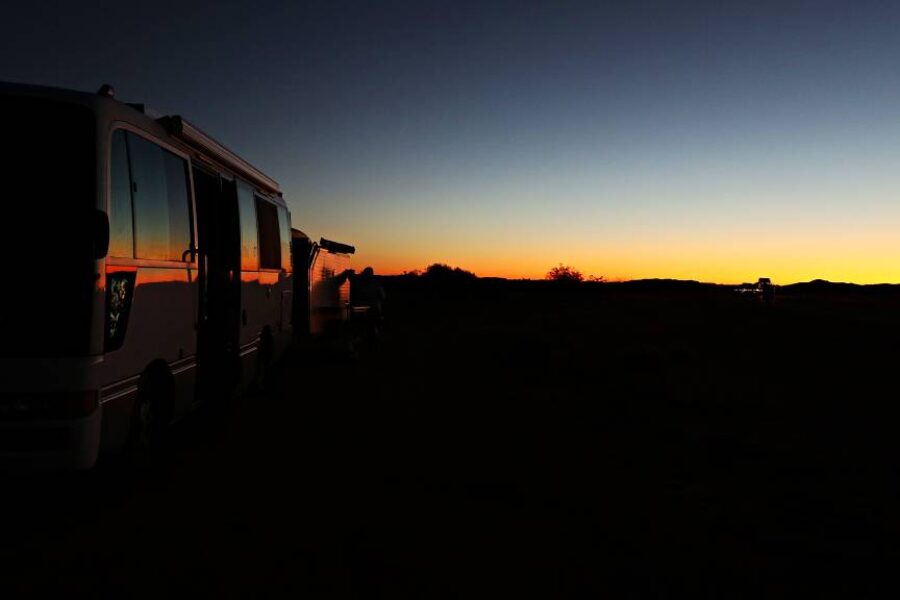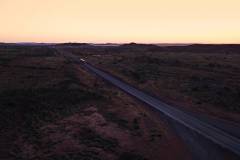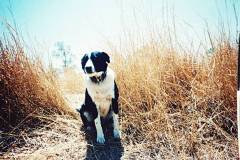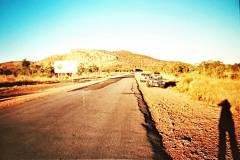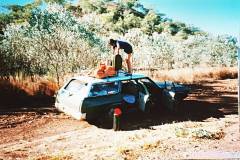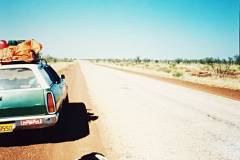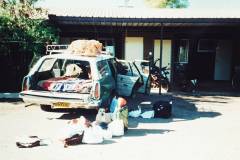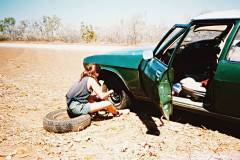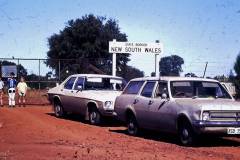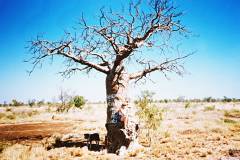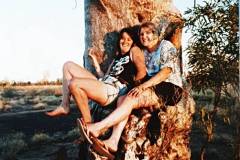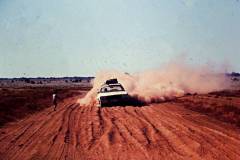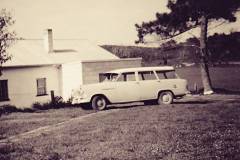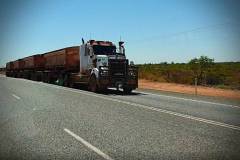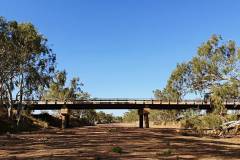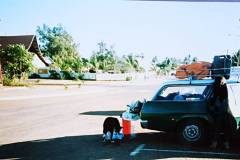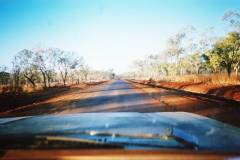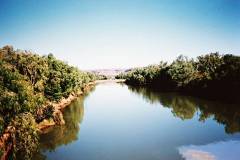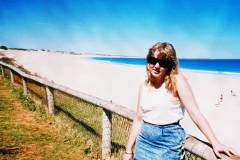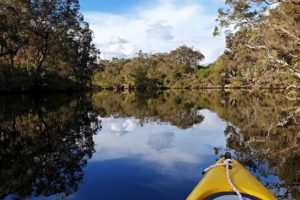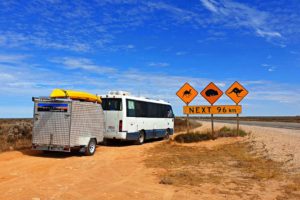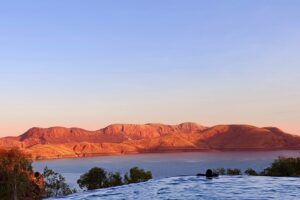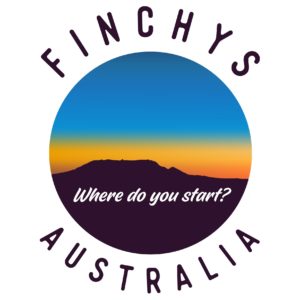Travelling the Kimberley | Then & Now
Looking up, the outback sky was inky, with millions of luminous stars littering the blackness. On such a dark night, the road-trains head lights looked deceptively close. Barrelling towards us down the long, straight stretch of isolated outback road, the shining orbs of light streamed miles out into the distance ahead of the rumbling of seventy-odd tons of truck.
We’d driven the whole day.
Travelling the Kimberley highway at midday was sizzling hot. By late afternoon it was still shimmering, but as evening arrived the red dirt verges began to cool. Not that you’d call it a highway. Back in ’88 it was a single lane of black top with 3″ gutters dropping off both sides. Drop a front wheel off that lip at 110kms hour and the whole car would head for the scrub. You didn’t want to be jerking the steering wheel suddenly back to the right either to get back on track or you’d end up in the opposite lane heading into oncoming traffic or upside down sliding up the road on the roof as I saw happen once on the outskirts of my home town in South Australia.
“The Cabbage” was green. Not actually cabbage green but a much darker shade, more like Irish Moss green. Roof racks hovered over the white roof where we stowed three metal Jerry cans of fuel and an orange plastic jerry signalling it contained fresh water. There was plenty of room on top as The Cabbage was a station wagon.
Anyway, I never did know the truth of how this famous old Holden HQ wagon actually got its name but “The Cabbage” was well known for its travels around Australia.
It was Carnarvon where I began my journey in The Cabbage over The Top End of Australia. Through the outback regions of the Pilbara and travelling the Kimberley.
Up to this stage as far as vehicles go, 1987 and 1988 had been considerably predominate years for HQ’s in my life.
All Australian made from 1971, the HQ Holden was the next stage in Holden’s development going from the squarer models like the HR and HT, or the Kingswood’s and Belmont’s to the much smoother lined, rounder featured HQ. Nearly half a million HQ’s were built in three years with competition for the new flagship vehicle coming from the Ford Falcon and the Chrysler Valiant.
I met Finchy in Perth in 1987 and we were both proud owners of HQs. Mine I’d bought from the Western Australian town of Toodyay (pronounced Two Jay) which anyone in Perth would know as the number plate started with the letter T followed by four numbers. Mine was a golden coloured sedan which I paid $900 for. I’d bought it to drive from York where I was working as a nanny in Western Australia’s wheat belt country into Perth on the weekends to visit friends. York is Western Australia’s oldest inland town, situated on the Avon River almost one hundred kilometres east of Perth.
Finchy’s was an orange station wagon that he’d bought in Adelaide. He drove it through Victoria and Northern New South Wales and then headed West across the Nullarbor as many young fellas did at that time looking for work. Finchy paid $1000 for his HQ. It was in pristine condition when he’d purchased it, he’d told me.
For some reason HQ number plates just stick in your head.
Ask any older HQ owner and they’ll reel off their HQ number plate even if they can’t remember their current vehicle plate. Finchy recites his easily: RDO – 758. Ask any member of my family and they’ll recite the plate of the yellow HQ my father bought brand new in the early 70’s for $3000. Actually, you could probably ask any of his close mates or their kids and they’d say RDR – 413.
To get to Carnarvon from Perth I hitched a ride with a girlfriend and her toddler in her brown HQ panel van. It was late winter in 1988 when I left Perth and I headed into early Spring travelling through the Pilbara and Kimberley regions on my way to Darwin. The country was red dirt, spinifex grass, boabs, wedgetail eagles and full flowing rivers underneath the bridges.
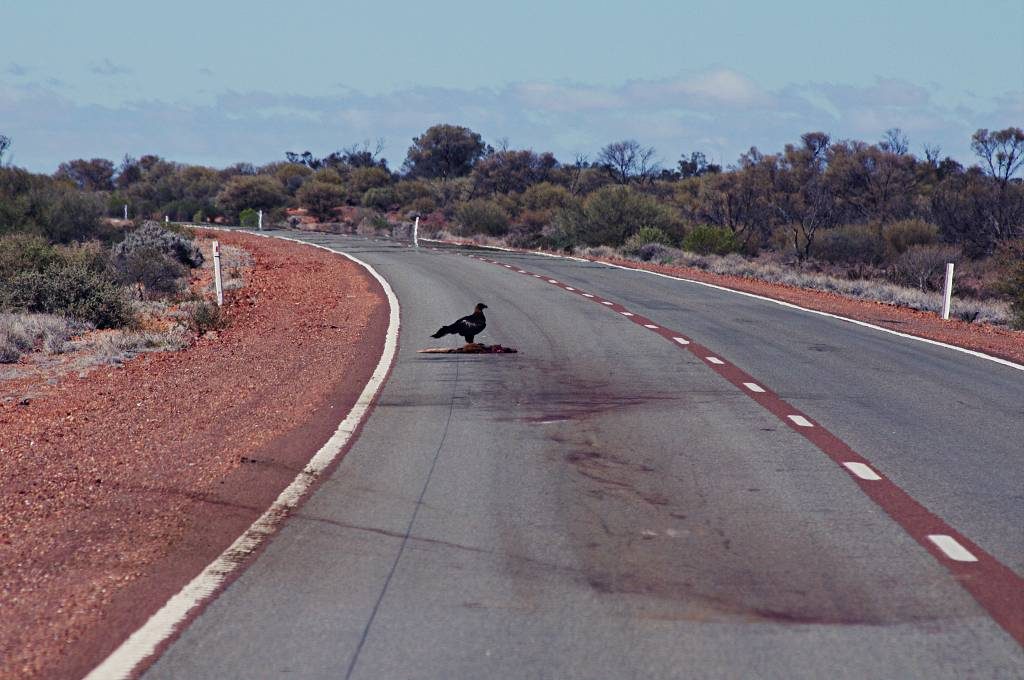
The Cabbage was owned by another close friend, Jillie who I have travelled extensively with since our first trip over the top. Two years later we did the Big Lap in the opposite direction, circumnavigating the whole country anticlockwise in my Holden Torana, a feisty little SL named Muddy and a third girlfriends’ banana yellow HQ panel van called “The Tiger Moth”. The three of us came from SA, WA and NSW and took almost a year to do the Big Lap together. We spent time visiting each region we originated from. You certainly get a better experience visiting a region with a local.
I chucked my large floppy green army bag with all my worldly possessions from one HQ to the other and left Carnarvon with Jillie and her big fluffy black and white dog called Cactus. Some cars have names and some don’t. Some dogs have names and then some dogs have NAMES. Cactus was his common everyday calling your dog to come to me name, but his official title was: Cactus George Negus Dash the Third.
Cactus traveled well. It was what he did.
Three other mates got a lift from Carnarvon to Karratha with us so The Cabbage carried Jillie and myself in the bench seat in the front, the three passengers in the back seat and Cactus amongst the luggage somewhere behind that.
On leaving Karratha we left our extra passengers behind, lowered the back seat down, found a foam mattress and lay that in the back, then repacked the gear Jillie travelled with and took off for the Territory. A Holden station wagon could fit a double bed mattress in the back making it an optimal travelling machine.
My parents travelled in my grandad’s station-wagon on their honeymoon along the Great Ocean Road. The wagon had curtains in the back (as did Finchys) and as the newlyweds lay in back gazing dreamily at the starry skies over the Victorian coastline somewhere near The Twelve Apostles, a peeping Tom peered through a side window back at them. The whole episode scared mum so much that she had an asthma attack and dad had to find a hospital in the middle of the night.
Heading for Broome we chucked a bag of ice on the front floor, ripped a hole in it and stuffed a couple of sweet ciders in, wound down the windows (as there was no air con) and drove off, with our long hair blowing out the car windows and Cactus with his ears flapping in the breeze.
Jackson Browne full blast on the stereo, rolling away the miles passing just another town along the road.
We suffered a front flat tyre 200kms East of Fitzroy Crossing at midday in 40-degree heat. We climbed up on the roof racks to get the spare down and noticed Cactus heading off along the roadside to do some doggy investigation.
In my mind this memory is hot, dusty and hard work but looking back at my diary I wrote it was “hilarious”. I don’t know exactly what was hilarious about it except that travelling with Jillie was always fun and full of laughs. Maybe the hilarious moment was when Cactus hopped back in the car soaking wet. How he found water and got that wet when all we could see was red desert for miles was beyond comprehension.
Boab trees can survive drought and fire. Jillie and I claimed one as our own on that trip across the Great Northern Highway. It was back off the road a bit so it wasn’t as popular as some of the bigger Boabs that have rings of bare earth around them from all the tourists stopping to check them out. Excessive foot traffic around a Boab tree can expose its roots and kill it apparently.
There was no such thing as a selfie then, no such thing as a mobile phone. The truckies had 2-way radio’s but we didn’t have one of those either. We didn’t even have a car radio that worked but we did have a cassette player and plenty of music cassettes. TDK cassettes of course, that we had recorded our records onto and that we kept in a cardboard box behind the front seat. And good speakers. Pioneer car stereo speakers were the go-to speakers of the day. You didn’t have a car stereo if you didn’t have a Pioneer system.
Back to the boab. We stopped in 1988 near this medium size Boab tree. It was about 100m off the road and had a large wound on its western side as well as a big sticky out bit which we decided to sit on to take photos of each other with my Pentax film camera. There were no other Boabs of note around it and it was in fairly clear open grassland surrounded by a smattering of ochre coloured anthills.
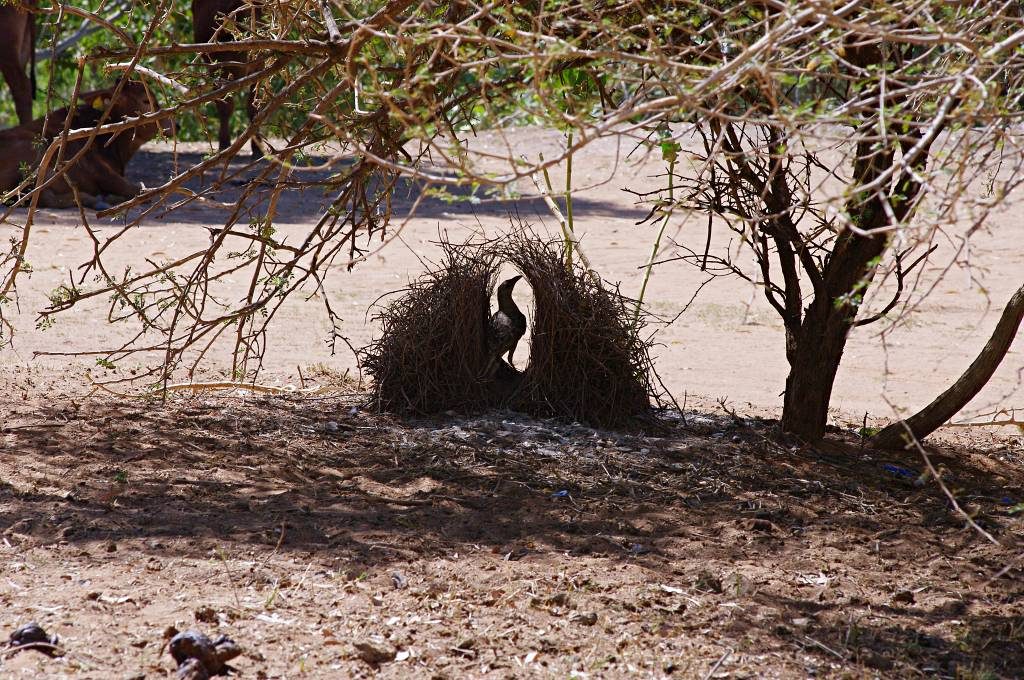
We took photos of each other and of Cactus George Negus Dash the Third and proclaimed it to be “our tree”. Little did we know that two years later we’d be leering through the windscreen trying to spot that exact tree along a 300kms stretch of good-looking boabs to take photos at again.
But we did.
I drove past it in Muddy and had to turn around – quite easy on a road with big wide red dusty edges. Travelling the Kimberley a few months later in the wet season and I wouldn’t have been doing a U-ee. You could see the deep wide trenches left by trucks and other vehicles from the last wet season when the roadsides would have been a muddy red bog and many causeways and creek beds under water or washed out.
My girlfriends in the yellow HQ had seen the boab and stopped. We got out of our Holden’s and stomped through the spinifexy grass tufts in our thongs and perched ourselves on the Boab and got some lovely shots near on sunset.
Travelling the Kimberley on our trip heading East, a few decades later, Finchy and I tried to find the tree.
We couldn’t guess how much a Boab tree would have changed in thirty years. They can live to a thousand years or more so in thirty years it shouldn’t have changed too much. Anyway, we couldn’t locate the exact tree but found one very similar and took some happy snaps on our phones for a memento. Ironically, I was wearing near identical clothing, a black and white top and black shorts.
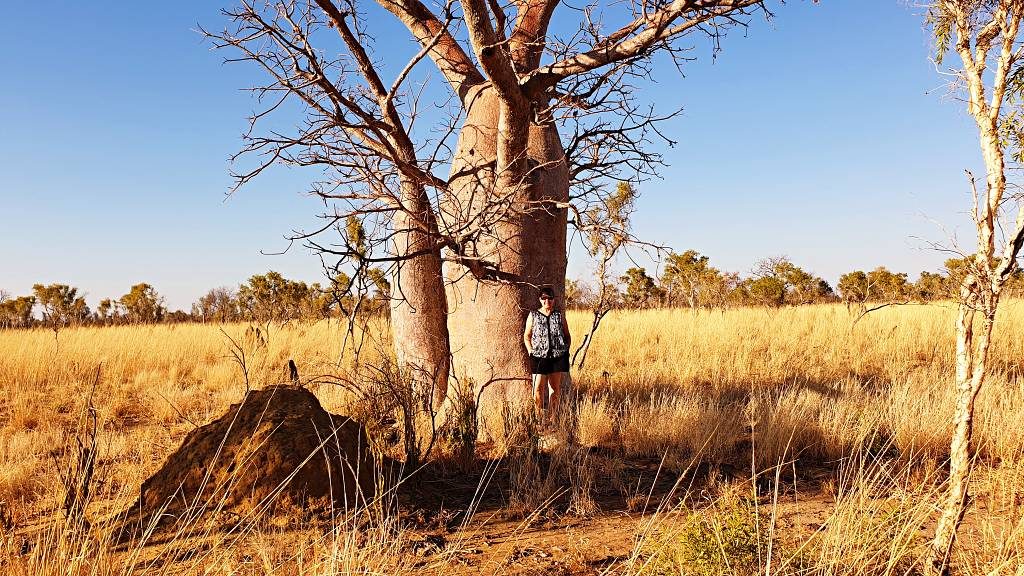
The 2018/19 wet season was the driest since 1992 and the hottest on record. Every river and creek we crossed was dry. Some had pools of water but very few. Some stock (cattle) we saw from stations either on or near the highway looked extremely parched. One cow looked fried on its feet and wouldn’t have made the day out I reckon. It stood over another recently deceased cow and was the saddest sight as we drove past.
Finchy and I passed dozens and dozens of triple road trains as we headed East on our way to Darwin from Western Australia in Fork the Bus. Quite a lot were stock crates but very few had stock in them. On a still night parked up in a road side stop you can sometimes smell the semi coming when it’s a stock truck.
The road train that was 3-4 kms away at the start of my story was now less than 1 kilometre. Driving in the dark is not advisable in many outback regions in Australia but this was 1988 and travelling at night was more commonplace. We knew we had to get right off the narrow strip of bitumen and onto the dirt to let the road train pass – they liked to keep their tyres on the bitumen at all times for the same reasons I mentioned earlier.
So, we had all our wheels in the dirt and was driving slower than we had been, waiting for the roaring beast to pass. Its head lights getting closer all the time even though it felt like ages watching it come towards us through the blackness. Then its headlights met ours and out of nowhere, a fluoro yellow diamond shaped “beware of stock on the road” traffic sign appeared in front of us.
What the hell?
This road train is three trailers long and we both knew that the dog trailer twitches its tail from side to side and with one big sway could take us out if it had a wobble up. With no time to think and only time to react Jillie swung the steering wheel to the left and missed the sign by inches. Thank God we didn’t veer to the right or I’m sure the last trailer would have clipped us. In the dark we couldn’t see the road edge drop away. The car plummeted down an embankment, red dust spewing over The Cabbage’s windscreen in the dark as we slid sideways, maintaining forward momentum with the headlights dimly lighting to who knows where.
Then we stopped. Silence.
Except for our hearts beating. Jillie broke the silence with, “Thank fuck we emptied those Jerry cans earlier or we’d have gone over for sure”. I swear we sat there for ten minutes. The road trains row of red tail lights trailing off in the revision mirror, before we swapped drivers again, and I gave the Cabbage all it had to get it back up the embankment back onto the highway.
Another day’s travel and we made it to Darwin. Finchy had been transferred with his job to Darwin and I started work nursing there soon after arriving. Jillie made her way down to the NSW coast in The Cabbage. A week after getting to Darwin I went to the chemist to see if the two packets of 24 shot film photo’s I had taken going across the top of Australia were back from being developed. I wrote in my diary that I was happy with my photos and put them into a new hard cover photo album, one of many, writing descriptive captions next to each shot.
We all met up again the next year in the sleepy little seaside town of Southend, but that’s another story. Where do you start?

